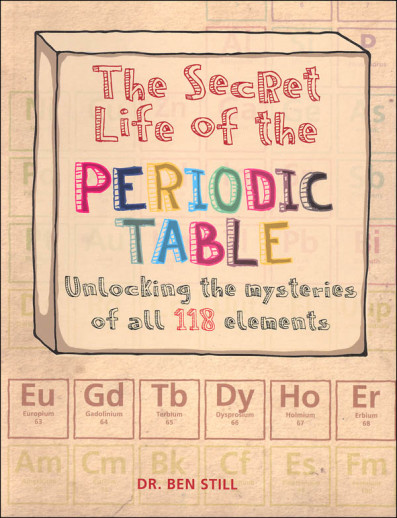We use cookies to make your experience better. To comply with the new e-Privacy directive, we need to ask for your consent to set the cookies. Learn more.
Secret Life of the Periodic Table
Understanding the elements of the Periodic Table can be difficult for chemistry students. This wonderful resource presents a bit of history and lessons of the past concerning the Periodic Table and chemistry; learn about Mendeleev, atomic physics, the Quantum atom, and trends and patterns before jumping into presentations for each of the elements. One to two pages per element will give information on characteristics, uses, and its discovery, along with atomic number, weight, abundance, radius, melting point, boiling point, configuration and the date of its discovery. Pictures and illustrations will keep the reader engaged in the topic at hand. The book is then rounded out with the "Hall of Fame" for scientists and researchers - Albert Einstein, Ernest Rutherford, Glenn T. Seaborg, and others. 192 pgs, pb. ~ Donna
Discover the hidden stories of the 118 elements.
The Secret Life of the Periodic Table uncovers the fascinating stories behind the formulation of the table. It describes how and who discovered the 118 elements, and the competition and cooperation behind scientific advances. The character of the elements is brought to life in a bright and engaging way, making The Secret Life of the Periodic Table ideal for students and general readers. Spared the monotony of a school text, they can gain a basic understanding of the fundamentals of atomic science.
The book covers all 118 elements in 14 chapters. They are:
- A brief guide to atomic physics
- Igor Mendeleev, arguably the most important formulator of the table, and significant others
- Hydrogen
- Alkali metals
- Alkaline Earth metal
- Transition metals
- Post-transition metals
- Metalloids
- Other non-metals
- Halogens
- Noble gases
- Lanthanoids
- Actinoids
- Transuranium elements.
Each element description includes a fact box showing atomic number, atomic weight, radius, melting point, boiling point, density, and the year of its discovery and by whom. There are many sidebars, boxes and extended captions covering topics of interest, like Ernest Lawrence's 1931 cyclotron, early precursor to the 10-km radius Large Hydron Collider that he could not possibly have imagined.
There is also fascinating trivia about the elements. For example, phosphorus was first isolated by an alchemist's search for gold in urine and in the 1920s, there was a fad for lethal radium cocktails.
The Secret Life of the Periodic Table is accurate and entertaining, making it a helpful adjunct to student studies. General readers will find it an enjoyable trip into the world of chemistry and atomic science. It is an ideal purchase for science, middle school and general collections.
Homeschool Chemistry Curriculum, Workbooks, Lab Materials, Kits, Games, and Chemistry Lab Supplies
| Product Format: | Paperback |
|---|---|
| Brand: | Firefly Books |
| Author: | Dr. Ben Still |
| Grades: | 7-AD |
| ISBN: | 9781770858107 |
| Length in Inches: | 9.75 |
| Width in Inches: | 7.5 |
| Height in Inches: | 0.5 |
| Weight in Pounds: | 1.4 |

